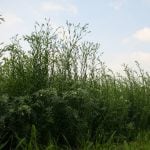Michelle Hubbard, an Agricutlure and Agri-Food Canada researcher, says chickpea-flax intercrop works to reduce ascochyta blight disease. She shares some theories on why.


The intercrop works for reducing the disease, but Michelle Hubbard, an Agricutlure and Agri-Food Canada researcher, is still working on the why

From seedling issues to stand die-off, understanding the timing and symptoms of alfalfa diseases can help protect yield

Warmer, wetter, longer growing seasons carry risks as well as rewards

Lab-testing canola stem samples can help verify the disease and its specific race

The return on investment can come from improved efficiency, helping growers get the most out of a crop under variable growing conditions

For Manitoba the ‘honeymoon’ is ending as soy diseases such as phytophthora root rot arrive



Prairie-wide, variety-specific FHB risk maps now available online
